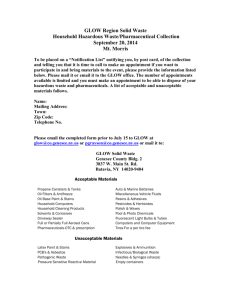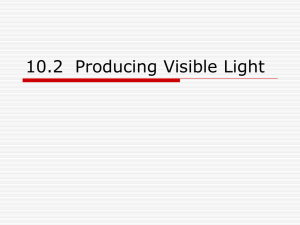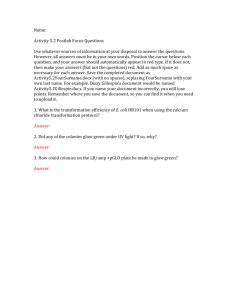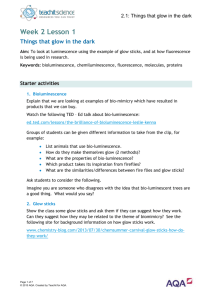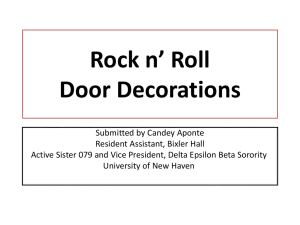Lesson - Vanderbilt University
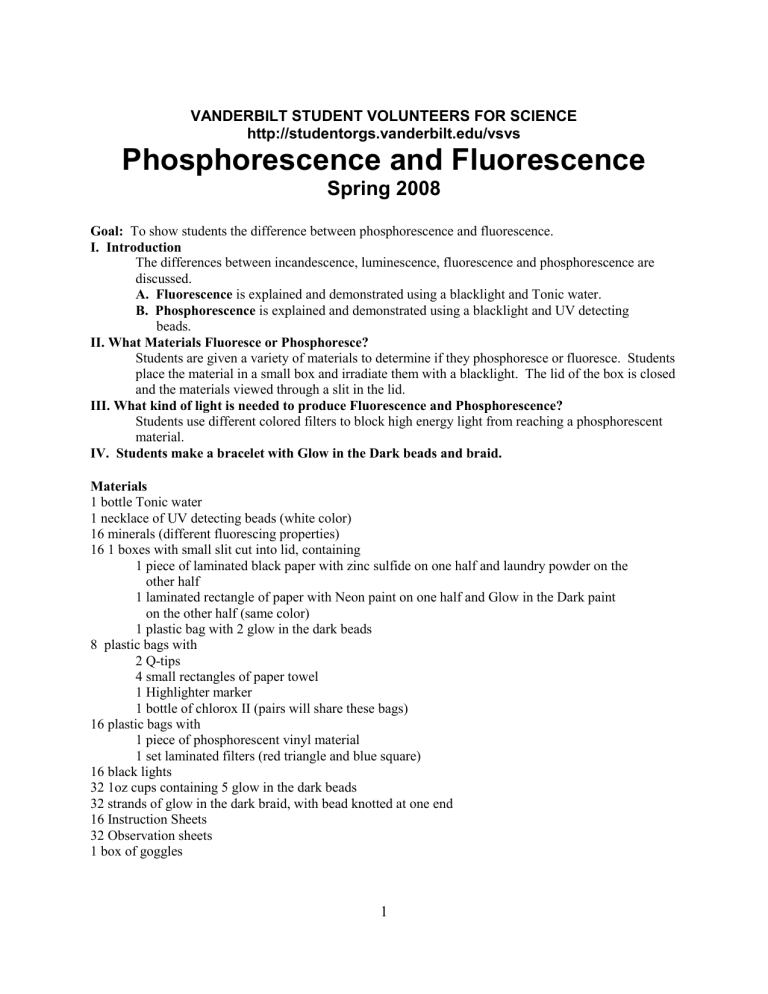
VANDERBILT STUDENT VOLUNTEERS FOR SCIENCE http://studentorgs.vanderbilt.edu/vsvs
Phosphorescence and Fluorescence
Spring 2008
Goal: To show students the difference between phosphorescence and fluorescence.
I. Introduction
The differences between incandescence, luminescence, fluorescence and phosphorescence are discussed.
A. Fluorescence is explained and demonstrated using a blacklight and Tonic water.
B. Phosphorescence is explained and demonstrated using a blacklight and UV detecting
beads.
II. What Materials Fluoresce or Phosphoresce?
Students are given a variety of materials to determine if they phosphoresce or fluoresce. Students place the material in a small box and irradiate them with a blacklight. The lid of the box is closed and the materials viewed through a slit in the lid.
III. What kind of light is needed to produce Fluorescence and Phosphorescence?
Students use different colored filters to block high energy light from reaching a phosphorescent material.
IV. Students make a bracelet with Glow in the Dark beads and braid.
Materials
1 bottle Tonic water
1 necklace of UV detecting beads (white color)
16 minerals (different fluorescing properties)
16 1 boxes with small slit cut into lid, containing
1 piece of laminated black paper with zinc sulfide on one half and laundry powder on the
other half
1 laminated rectangle of paper with Neon paint on one half and Glow in the Dark paint
on the other half (same color)
1 plastic bag with 2 glow in the dark beads
8 plastic bags with
2 Q-tips
4 small rectangles of paper towel
1 Highlighter marker
1 bottle of chlorox II (pairs will share these bags)
16 plastic bags with
1 piece of phosphorescent vinyl material
1 set laminated filters (red triangle and blue square)
16 black lights
32 1oz cups containing 5 glow in the dark beads
32 strands of glow in the dark braid, with bead knotted at one end
16 Instruction Sheets
32 Observation sheets
1 box of goggles
1
I. Introduction
Ask students to name some hot objects that give off light.
Some examples are burning wood in fireplaces, incandescent light bulbs, a lit match, and fireworks.
Ask the students to name some objects that give off “cold” light?
Fluorescent light bulbs emit cold light .
There are two general classifications of visible light.
A.
Incandescence, known as hot light, refers to light that is emitted by a heated filament, such as that found in the regular light bulb.
B.
Luminescence , known as cold light, refers to light that a substance emits without an increase in temperature, such as the fluorescent light bulb.
This lesson focuses on 2 types of Luminescence – Fluorescence and Phosphorescence. There are other types of cold light (chemiluminescence and bioluminescence) that will not be discussed
Tell students to look at the flow chart in their handout. Explain the difference between Fluorescence and
Phosphorescence.
Visible Light
Incandescence
“hot light”
Is the light hot or cold? yes no
Luminescence
“cold light”
Phosphorescence
- continues glowing after
light is removed
Fluorescence
- stops glowing after light
is removed
2
A. Demonstration of Fluorescence: Tonic Water
Fluorescence occurs when light (often UltraViolet (UV) light) excites electrons in a molecule to higher energy levels.
When the electrons return to the ground state, visible light is emitted. When the energy source is removed, the fluorescing material stops glowing.
Tonic water appears colorless in ordinary light.
However, it is fluorescent-blue under ultraviolet radiation.
The substance in tonic water that causes this is quinine, which absorbs UV radiation and emits blue light.
Tell students you are going to be using a black light. Students are probably familiar with a black light but what they may not know is why it’s called a black light. o A black light emits UV radiation in the 300-400nm range and some visible light. It works in the same way that fluorescent lights work. Both bulbs contain
mercury vapor inside the bulb. When the bulb is electrified, electrons of the mercury atoms are excited and when they return to the ground state, UV light is emitted. o In fluorescent bulbs, the UV light is absorbed by the white coating (the phosphor) and reemitted as white light. o In black lights, a different phosphor is used to produce the UV light, as well as a special glass for the bulb which blocks almost all of the visible light. o The light seen coming from a blacklight, is the violet visible color, but the blacklight is also emitting UV radiation that is invisible.
Shine the black light on the bottle of tonic water.
Point out that the tonic water does not glow after the black light is turned off.
B. Demonstration of Phosphorescence: UV Detecting Beads
Phosphorescence generally occurs by the same process as fluorescence except there is a time delay before all the electrons eventually return to the ground state so visible light continues to be emitted after the radiation (UV or visible) source is removed.
Show the students a string of the beads and point out the white color. Shine a black light on the necklace for about 20 seconds, until the beads change color. o The change involves a dye molecule absorbing UV energy to produce a different geometric isomer of the molecule. When the UV energy is removed, the color slowly fades as the dye molecule rotates back to the more stable form.
Objects that glow in the dark are examples of phosphorescent materials. They contain a chemical that has the ability to absorb light energy quickly and then emit it slowly.
Ask the students to give examples of "glow-in-the-dark" materials. Examples include digital watches that glow in the dark and numerous toys, especially items sold around Halloween.
II. What Materials Fluoresce or Phosphoresce?
Note : Tell the students to follow the order on their observation sheet. The Chlorox II and highlighter pen samples will be prepared by the students (tell them to write their initials on the paper towel). The mineral will be distributed at the end.
Tell students to wear goggles while doing this experiment.
Show students how to do the following:
1.
Place one of the materials being investigated inside the box.
3
2.
Record observations about the color of the material before it is illuminated.
3.
Turn the black light on and place it upside down over the box so that it is shining into the box.
4.
Wait about 20 seconds (students can count) and record observations about any changes in the material (has it changed color, is it glowing,…?).
5.
Remove the blacklight and close the lid of the box. Look through the slit to see if the material is still glowing. Record the results.
6.
Have the students conclude if the material is fluorescing or phosphorescing.
Results
Material
Laundry
Detergent
Zinc Sulfide yellow
White paper label
Neon Paint
Glow in the
Dark Paint
Colored
Beads
Highlighter on paper towel
Chlorox II on paper towel
Paper towel
Mineral(s)
What Color is it in room light?
White white
Dull color
Dull color
Colored yellow
No color
How does it change under the blacklight?
Glows bluish
Glows yellow
Glows with a bluish tinge
Glows brightly, same color
Glows brightly, same color
Glows brightly, same color
Bright yellow
Blue color
Does it glow after the box lid is closed? no yes no no yes yes no no
Does it Fluoresce or Phosphoresce?
Fluoresce
Phosphoresce
Fluoresce
Fluoresce
Phosphoresce
Phosphoresce
Fluoresce
Fluoresce neither
Fluoresce
Dull white
Various colors
No change
Specks change color and glow no no
Background Information
1. Zinc Sulfide – Phosphoresces:
Materials such as zinc sulfide that phosphoresce are called “phosphors.”
Electrons in zinc sulfide are exited by light to higher energy levels.
Then when the light source is removed, the excited electrons gradually return to the lower energy ground state.
During this time the substance appears to glow because the difference in energy between the excited state and the ground state is emitted as light.
Once all the excited electrons have returned to the ground state, the substance ceases to glow.
However, every time the substance is exposed to light the electrons are excited up to a higher
4
energy level so when a phosphorescent substance stops glowing, just turn on the lights for a few minutes to "recharge" the substance.
2. UltraClorox 2 – Fluoresces.
UltraClorox 2 lists an optical brightener as one of its ingredients.
Bluing is also added to laundry detergent to make clean clothes look whiter.
These additives are called optical brighteners because they absorb UV light and emit visible light through fluorescence.
When optical brighteners are incorporated into textiles, they make the material appear brighter and whiter, thus giving the appearance of being cleaner.
Students see blue color immediately after the black light is shone, but the blue color is gone as soon as the black light is removed. It cannot be seen glowing in the box after the lid is closed.
3. Mineral Information:
Explain that some minerals are fluorescent. Scapolite fluoresces a bright yellow under the black light. See the mineral information chart for other examples.
4. White paper – Fluoresces:
White paper fluoresces and paper towel does not fluoresce.
Optical brighteners are added to high quality paper (such as copy paper), but not to cheaper paper towels.
III. What kind of light is needed to produce Fluorescence and
Phosphorescence?
Materials:
1 box with lid
1 piece of phosphorescent vinyl
1 set laminated filter pieces
Tell students to place the yellow vinyl material in the box and close the lid.
View it through the slit – it will probably be glowing (phosphorescing).
Wait until the glowing subsides and then do the following experiment.
1. Look at the laminated filters and note that each color has a different shape.
2. Take the vinyl out of the box and immediately place the filters on top of so that the red
triangle is on the left and the blue on the right.
3. Leave exposed in the room light for about 1 minute.
4. Remove the filters and immediately place the vinyl in the box and close the lid.
5. Record which shape is not glowing.
6. Record which filter color prevented the material from phosphorescing.
Tell students to look at the electromagnetic spectrum on their Instruction sheet.
White light contains wavelengths ranging from 400-700nm, with energy in the range 1.8 to 3.1 electron volts.
Some materials need UV light to glow, while others (like the zinc sulfide) can be excited with white light.
It is the high energy (blue) component of the white light that excites it. What does the filter do? o The red filter blocks high energy, so the vinyl does not phosphoresce. o The blue filter lets through high energy so the vinyl does phosphoresce.
5
Source: http://nasaexplores.nasa.gov
Long Wavelength 700 nm
Lower Energy 1.8 eV
Short wavelength 400 nm
Higher Energy 3.1 eV
III. What kind of light is needed to produce Fluorescence and
Phosphorescence?
Materials
1 piece of phosphorescent vinyl
Red, blue and white LED lights
Tell the students to gently draw a “squiggle” on the yellow vinyl material, using the LED lights in the following order:
Blue
6
White
Red
Record which LED’s made the material from phosphoresce.
Tell students to look at the electromagnetic spectrum on their Instruction sheet.
Long Wavelength 700 nm
Lower Energy 1.8 eV
Short wavelength 400 nm
Higher Energy 3.1 eV
For your Information: white light contains wavelengths ranging from 400-700nm, with energy in the range 1.8 to 3.1 electron volts.
Tell the students that some materials need UV light to glow, while others (like the zinc sulfide and the vinyl) can be excited with white light.
The energy of the white light needs to be from the higher energy (the blue end) end of the spectrum. The red light does not have enough energy to make the material phosphoresce.
III. Making Glow in the Dark Bracelets.
Pass out the beads and braid and have the students make a bracelet.
Lesson ideas were taken from Educational Innovations kits.
Lesson written by: Pat Tellinghuisen VSVS Program Director, Vanderbilt University
Mel Joesten Professor Emeritus, Vanderbilt University
7
Instruction Sheet
You must wear goggles while doing this experiment.
I. Observe demonstrations
of Fluorescence (tonic water and a blacklight and
Phosphorescence (blacklight and UV detecting beads).
II. What Materials Fluoresce or Phosphoresce?
1. Follow the order of materials in the observation sheet.
2. Place the first material (the black laminated paper with zinc sulfide and laundry detergent)
inside the box.
3. Record observations about the color of the material.
4. Turn the black light on and place it upside down over the box so that it is shining into
the box.
5. Wait about 20 seconds (count to 20) and record observations about any changes in the
material (has it changed color, is it glowing,…?).
6. Remove the blacklight and close the lid of the box. Look through the slit to see if the
material is still glowing. Record the results.
7. Conclude if the material is fluorescing or phosphorescing.
8. Prepare the Chlorox II and highlighter pen samples
Write initials on the paper towel with the highlighter.
Repeat with the Chlorox II and a cotton swab.
9. VSVS members will distribute mineral for you to observe.
III. What kind of light is needed to produce Fluorescence and
Phosphorescence?
1. Place the yellow vinyl material in the box and close the lid. View it through the slit – it will probably be glowing (phosphorescing). Wait until the glowing subsides and then do the experiment.
2. Look at the laminated filters and note that each color has a different shape.
3. Take the vinyl out of the box and immediately place the filters on top of so that the red triangle is on the left and the blue on the right.
4. Leave exposed in the room light for about 1 minute.
5. Remove the filters and immediately place the vinyl in the box and close the lid.
6. Record which shape is not glowing.
7. Record which filter color prevented the material from phosphorescing.
8. Look at the electromagnetic spectrum on the Instruction sheet.
What does the red filter do?
What does the blue filter do?
III. Make a Glow in the Dark Bracelet.
8
Source: http://nasaexplores.nasa.gov
Long Wavelength 700 nm
Lower Energy (about 1.8 eV)
Short wavelength 400 nm
Higher Energy (about 3.1eV)
9
Material
Laundry
Detergent
White paper label
Neon Paint
Glow in the
Dark Paint
Colored
Beads
Highlighter on paper towel
Chlorox II on paper towel
Paper towel
Mineral(s)
What Color is it in room light?
White
Zinc Sulphide yellow white
Dull color
Dull color
Colored yellow
No color
Observation Sheet - Answers
II. What materials Fluoresce or Phosphoresce?
How does it change under the blacklight?
Glows bluish
Glows yellow
Glows with a bluish tinge
Glows brightly, same color
Glows brightly, same color
Glows brightly, same color
Bright yellow
Blue color
Does it glow after the box lid is closed? no yes no no yes yes no no
Does it Fluoresce or Phosphoresce?
Fluoresce
Phosphoresce
Fluoresce
Fluoresce
Phosphoresce
Phosphoresce
Fluoresce
Fluoresce neither
Fluoresce
Dull white
Various colors
No change
Specks change color and glow no no
III. What kind of light is needed to produce Fluorescence and Phosphorescence?
What do you observe on the vinyl rectangle after the filters are removed?
There is a triangular shape that is not phosphorescing.
What does the red filter do? Blocks light energy from exciting the vinyl material.
What does the blue filter do? Lets light energy through so that the vinyl material is excited.
What kind of light energy is needed to make the vinyl rectangle phosphoresce? High energy
10
Material
Laundry
Detergent
Zinc Sulphide
White paper label
Neon Paint
Glow in the
Dark Paint
Colored
Beads
Highlighter on paper towel
Chlorox II on paper towel
Paper towel
Mineral(s)
What Color is it in room light?
How does it change under the blacklight?
Does it glow after the box lid is closed? yes yes no yes no yes no yes no yes no yes no no yes no yes no yes no
Does it Fluoresce or Phosphoresce?
Fluoresce
Phosphoresce
Fluoresce
Phosphoresce
Fluoresce
Phosphoresce
Fluoresce
Phosphoresce
Fluoresce
Phosphoresce
Fluoresce
Phosphoresce
Fluoresce
Phosphoresce
Fluoresce
Phosphoresce
Fluoresce
Phosphoresce
Fluoresce
Phosphoresce
III. What kind of light is needed to produce Fluorescence and Phosphorescence?
What do you observe on the vinyl rectangle after the filters are removed?
_________________________________________________________
What does the red filter do? __________________________________________________
What does the blue filter do? _________________________________________________
What kind of light energy is needed to make the vinyl rectangle phosphoresce? _________
11
